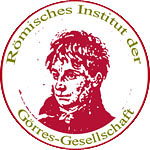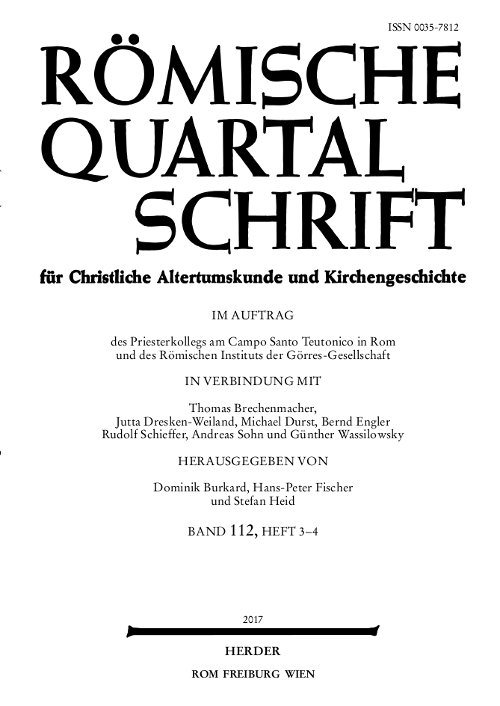Roman Quarterly
... for Christian Antiquity and Church History / Römische Quartalschrift für christliche Altertumskunde und Kirchengeschichte (RQ)
- the only catholic journal for the whole field of church history in the German language
- latest research on Rome, Italy and history
- one of the oldest journals in Rome (since 1887!)
- published twice a year in print and digital
- colour picture reproduction
- all issues and articles from 2010 onwards are available on the Herder website (subject to charge)
- highest international rankings (see below)
- customer service by Verlag Herder
- 40,- Euro reduced private subscription for members of the Görres Society (131,- instead of 171,- Euro)
- Student subscription for 99,- online, 115,- print.
RQ 1887-2009: open access (Index Theologicus)
RQ 2010 ff.: online (Herder)
index of subjects and persons 1956-2005
The "Römische Quartalschrift" (ISSN 0035-7812) originated, so to speak, as the house journal of the priests' college at the Campo Santo Teutonico (Vatican): It was founded in 1887 by the Rector of the Campo Santo, Anton de Waal (1837-1917), in order to do justice to the scientific claim of the priests’ college. For decades, the collegians and Görres scholars published their research in it. Since 1953, the journal has been edited "on behalf of the priests’ college at Campo Santo Teutonico in Rome and the Roman Institute of the Görres Society", currently by
- Prof. Dr. Stefan Heid (Rome) (responsible)
- Prof. Dr. Dominik Burkard (Würzburg)
- Dr. Peter Klasvogt (Rom)
in conjunction with the scientific board:
- Prof. Dr. Jörg Bölling (Hildesheim)
- Prof. Dr. Thomas Brechenmacher (Potsdam)
- Prof. Dr. Jutta Dresken-Weiland (Regensburg)
- Prof. Dr. Michael Durst (Chur)
- Prof. Dr. Bernd Engler (Tübingen)
- Prof. Dr. Britta Kägler (Passau)
- Prof. Dr. Matthias Simperl (Augsburg)
- Prof. Dr. Andreas Sohn (Paris)
As a rule, RQ publishes all articles in German. This is intended to preserve and promote German as the worldwide language of scholarship. However, articles may also be submitted in other European languages. If necessary, they will be translated into German for publication.
The RQ covers the whole of church history, including Christian archaeology, and is located in the area of Catholic church historiography. It publishes essays and reviews. It sees itself as a strictly scholarly, source-oriented organ. Every contribution received is subjected to the peer review process, i.e. it is subjected to at least two scholarly reviews; only then do the editors decide on acceptance. Conditional acceptance may also be granted if corrections and amendments are imposed on the author.
Order now: in paper form or digitally - special price for members of the Görres Society
The Roman Quarterly as a whole or individual essays can be ordered directly from the publisher Herder. Open your personal account here. Members of the Görres-Gesellschaft can subscribe to the combination subscription (print + digital) at a reduced price of € 40 (€ 131 instead of € 171).
Optimal rankings
- In the LITARS (Louvain Index of Theology and Religious Studies for Journals and Series, 2020) the RQ belongs to the category IJ-1: "the absolute top-class series".
- On the ERIH Initial List "Religious Studies and Theology" (2007) of the European Science Foundation, the RQ is ranked at the highest level A (ERIH-PLUS).
- In the ranking of the Italien Agenzia Nazionale di Valutazione del Sistema Universitario e della Ricerca the RQ ranks in the highest Classe A.
- The RQ was included in the ESCI citation index in 2018.
- The RQ is in the index of the EAAE.
The advantages for our authors
- High quality colour illustrations
- peer-reviewed journal with optimal rankings
- all articles are accessible online worldwide
- open access publication with DOI system is possible
- 250,- Euro honorarium for young authors (without legal entitlement)
- publisher's PDF of own contribution
- 30 specimen copies of the entire issue free of charge
- Supplement volumes of RQ at a discount
Notes for authors
Manuscripts must be sent as Word and PDF files to
Formal layout / citation guidelines
If an essay is accepted, it has to be edited and revised by the author according to the wishes of the editors. You can get an idea of the formal layout and citation guidelines by looking at the last issues of the journal (sample page).
As a matter of principle, illustrations should be submitted in high-resolution digital form, as individual files, not embedded in other documents (guidelines).
- Details
- Written by: Super User
- Category: Roman Quarterly
 Römisches Institut der Görres-Gesellschaft
Römisches Institut der Görres-Gesellschaft







